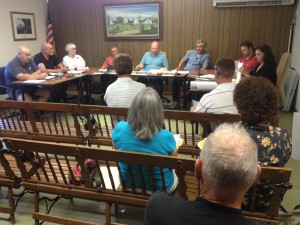After months of deliberations, Shawmut Associates LLC got the green light on Tuesday to redevelop the C&D Waste Recycling Facility at 50 Cranberry Highway, which will more than double the square footage of the current structure – itself slated for demolition – while making the site one of the highest-producing recycling centers in the region.
Representatives for the new company, Zero Waste Solutions, said it will recycle 95 percent of the materials that come through its facilities and start construction in August.
“I want to thank the people of Rochester and the members of its boards and commissions,” said Michael Camara of Shawmut parent company ABC Disposal Service Inc. “This is a game changer. It will put Rochester and Massachusetts on the map and set the new norm for waste management and recyclables.”
Board members Ben Bailey and Susan Teal recused themselves from the vote, which had to be a supermajority for approval. Five of the five voting members supported the applicant after plans were revised to satisfy conditions. The public hearing had closed earlier this month.
Elsewhere on the agenda, Conservation Commission Chairman Rosemary Smith – speaking additionally as a member of the Open Space Action Committee – and Conservation Agent Laurell Farinon shared with the Planning Board their vision for the Community Preservation Act, which they plan to present at Fall Town Meeting.
The CPA is a state law passed in 2000 that allows communities to establish a local fund to support affordable housing, parks and recreation (including athletic fields), open spaces and historic resources. Those municipalities that do adopt the act – currently 155 across Massachusetts – also receive a percentage of matching funds from the statewide Community Preservation Trust Fund each year.
Participating towns and cities raise CPA funds through a surcharge on property taxes. Smith said that the Rochester article would ask voters for a 1.5 percent increase (3 percent is the maximum), an average of $47 per homeowner annually, according to Smith’s calculations.
The town defeated the measure in 2006, and the majority of Planning Board members expressed their own distaste for the CPA and skepticism that it would meet a better fate in 2013.
“I helped with the Open Space plan, and I’m a proud member of the Rochester Land Trust, but I’m concerned on several points,” Chairman Arnold Johnson said. “It’s a tax on the tax. I personally think there’s going to be a backlash.”
Bailey was adamant in his opposition.
“You’re forcing more money out of people’s pockets to fund projects they don’t want,” he said. “Even it is only $50, why do I want to pay another tax? This program is very overreaching.”
Other members called the CPA “wasteful” and a “hurt to residents in a rough economy.”
Teal was the Planning Board’s lone supporter of the CPA.
“Had we gotten in in 2006, the funds would have paid for the Town Hall renovations, the Dexter fields, a lot of projects,” she said. “Rochester would be way ahead. It benefits all of us. Nobody wants to pay additional taxes, but we do want additional services. It is a functioning mechanism.”
Johnson and others argued that voters end up approving those projects almost without exception at Town Meeting, while CPA-funded projects would be hand-picked by a board.
By meeting’s end, the tone had softened, with Johnson suggesting that the Open Space Action Committee ask residents attending the upcoming Country Fair what they think, while Board member John DeMaggio asked if they would consider a 1 percent surcharge instead of 1.5 percent. Smith and Farinon thanked the Planning Board for its feedback.
By Shawn Badgley
